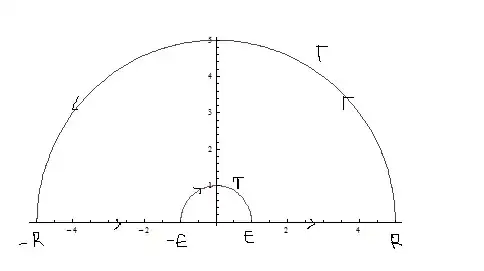I am trying to integrate $\displaystyle \int_0^\infty \frac{\sin^2(x)}{x^2} dx$ by method of contour. I am considering the following contour but I am not being able to. Also I am not sure if it's right approach.

$$\int_\Gamma f(z) dz + 2 \int_0^\infty f(z) dz + \int_\gamma f(z)dz = 0$$ The first integral tends to zero as $R \to \infty $, but letting $\epsilon \to 0$, for the last integral I am getting. $$\int_{\pi }^0 \frac{\sin^2({\epsilon e^{i\theta}})}{\epsilon^2 e^{i2\theta }} i \epsilon e^{i\theta}d\theta = 0$$
ADDED:: Taking the above contour, we do not have any pole inside the contour. $$\int_{-\infty}^\infty \frac{1 - e^{i2z}}{2z^2}dz + \int_\Gamma \frac{1 - e^{i2z}}{2z^2} dz + \int_\gamma \frac{1 - e^{i2z}}{2z^2} dz = 0 \hspace{1 cm }(1)$$
$\displaystyle \int_\Gamma \frac{1 - e^{i2z}}{2z^2} dz \to 0$ due to Jordan Lemma. To evaluate $\displaystyle \int_\gamma \frac{1 - e^{i2z}}{2z^2} dz $ let the radius of the small semi circle be $\epsilon \to 0 $.
$$\lim_{\epsilon \to 0}\int_\pi^0 \frac{1 - e^{i2\epsilon e^{i\theta}}}{2\epsilon ^2 e^{i2\theta}} i \epsilon e^{i\theta}d\theta =\lim_{\epsilon \to 0} \int_\pi^0 \frac{1 - 1 - 2i\epsilon e^{i\theta} + O(\epsilon^2)}{2\epsilon e^{i\theta}} i = \lim_{\epsilon \to 0} \int_\pi^0 1+ O(\epsilon) d\theta = -\pi \hspace{1 cm }(2)$$
From $(2)$, $(1)$ reduces to $$\int_{-\infty}^\infty \frac{1 - e^{i2z}}{2z^2}dz - \pi = 0 \implies \Re \int_{-\infty}^\infty \frac{1 - e^{i2z}}{2z^2}dz = \int_{-\infty}^{\infty}\frac{\sin(x)^2}{x^2}dx = \pi$$
Including singularity at $z = 0$, we will have that small inner circle on lower plane. $$\int_{-\infty}^\infty \frac{1 - e^{i2z}}{2z^2}dz + \int_\Gamma \frac{1 - e^{i2z}}{2z^2} dz + \int_\gamma \frac{1 - e^{i2z}}{2z^2} dz = 2 \pi i \text{Residue}[f(z), z = 0] = 2\pi \hspace{1 cm }(3)$$
As for $\displaystyle \int_\gamma \frac{1 - e^{i2z}}{2z^2} dz = \lim_{\epsilon \to 0}\int_{-\pi}^0 \frac{1 - e^{i2\epsilon e^{i\theta}}}{2\epsilon ^2 e^{i2\theta}} i \epsilon e^{i\theta}d\theta = \pi \hspace{1 cm }(4)$
From $(3)$ and $(4)$ we get the same result.